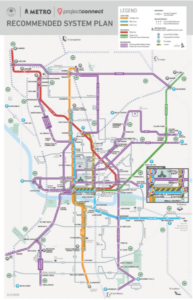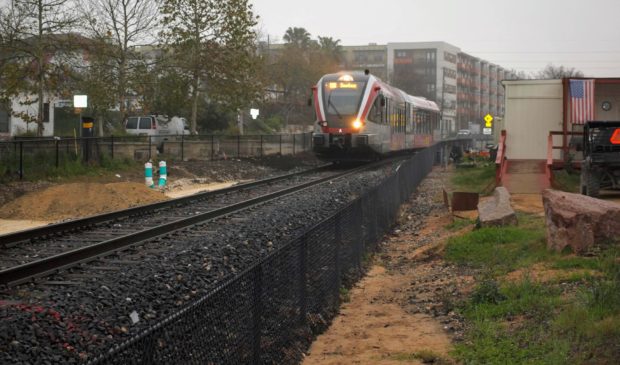City, Capital Metro adopt Project Connect with justice, sustainability in mind
Thursday, June 11, 2020 by
Ryan Thornton The Capital Metropolitan Transportation Authority Board of Directors and City Council adopted the final vision for an all-electric comprehensive transit system on Wednesday. Board members and city leaders said the $9.8 billion plan, featuring three light rail lines, a new commuter rail line through Northeast Austin and seven much-improved bus routes, would be transformative for the city as it aims in the direction of economic, racial and climate justice.

As demonstrated in a set of maps presented by Council Member Greg Casar in April, the 21-mile Orange Line – the system’s central light rail spine running from Tech Ridge to Slaughter Lane – travels right through many of North and South Austin’s lowest-income neighborhoods, as does the lower-ridership Blue Line light rail route, which runs south with the Orange Line from the North Lamar Transit Center, then east to the Austin-Bergstrom International Airport via East Riverside Drive.
Together with the Gold Line light rail route, which follows the Orange Line tracks before branching off downtown and heading northeast to Highland, the core of the system from North Lamar Transit Center to the South Congress Transit Center, will serve many of the city’s lowest-income residents on a five-minute frequency.
The plan also includes several fully electric bus rapid transit “light” routes serving East and Northeast Austin as well as the Green Line, a new commuter rail line that will run on existing tracks out to Colony Park, with potential to extend past Manor to Elgin in the future.
“(Project Connect) is the first time that I’m aware of that proposes true meaningful improvements to East Austin, including the far eastern crescent and beyond,” District 1 Council Member Natasha Harper-Madison said. “Better, more frequent buses that connect to major downtown transit hubs will provide increased access to the jobs, the schools, the hospitals and the other opportunities that are currently in short supply east of good old I-35.”
The plan, she said, may not be “the slam-dunk solution” for all of the city’s problems, but it is “one big step” toward addressing major issues like affordability and inequity, among other structural flaws.
“For the past 70 or so years, Austin has put all of its eggs in one basket and planned its famous growth exclusively around cars. That’s given us sprawl, it’s given us pollution, congestion, and frankly, countless deaths and severe injuries and an effective mandate that if you want to fully participate in our economy you have to have a driver’s license and you have to be able to afford a car note,” Harper-Madison said.
Looking back at previous transit initiatives he was not able to support, Williamson County representative Eric Stratton said he feels much differently this time.
“The last few weeks we’ve seen a lot of turmoil and a lot of, I would submit, awakening in communities around the country over the issues of race and equity,” he said. “Austin is no different and Austin has had problems with this for, I would submit, well over 100 years, from the redlining of the 1920s, to yes, even the actual construction of I-35 and beyond. And this, I believe, Project Connect, offers a real opportunity to take the next step forward and advance concepts of equity in our transportation transit system, to connect all parts of Austin.”
Going forward, Travis County Precinct 1 Commissioner Jeff Travillion said equity needs to be front and center in all planning efforts, prioritizing transit-accessible affordable housing and displacement prevention in order to avoid perpetuating the kinds of economic inequities the region faces today.
“I unfortunately said these same things in 2000 and was ignored,” Travillion said. “I think that the community wants to know affirmatively from all of us that we’re not going to make the same mistakes of even the recent past.”
Council Member Ann Kitchen ensured Travillion that equity will be emphasized, reminding him of Council’s resolution from April calling for policies and a fund to proactively address transit-related displacement ahead of construction on Project Connect.
The city is now seeking to define and establish the terms of a local government corporation that will allow the city to contribute a dedicated transit funding source from an 11-cent tax rate election if approved on the ballot in November. The city plans to post the proposal for a November referendum later this summer.
“I think that we have a system here that really is transformational,” Chair Wade Cooper said. “If you think about being able to step off an airplane at the airport and be at Republic (Square) in about 20 minutes, or to step onto the train at Tech Ridge and be downtown in 30 minutes, or at Slaughter and be at (the University of Texas) in 25 or 30 minutes, that really opens up the whole city to all of our citizens. And if you look at the demographics that have been measured around each of these projects, I think up and down the income scale in our community, we’re opening doors to education, to jobs, to health care, to cultural opportunities.”
The Austin Monitor’s work is made possible by donations from the community. Though our reporting covers donors from time to time, we are careful to keep business and editorial efforts separate while maintaining transparency. A complete list of donors is available here, and our code of ethics is explained here.
You're a community leader
And we’re honored you look to us for serious, in-depth news. You know a strong community needs local and dedicated watchdog reporting. We’re here for you and that won’t change. Now will you take the powerful next step and support our nonprofit news organization?





